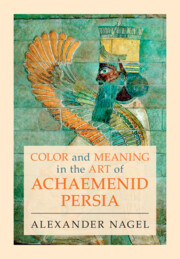Book contents
- Color and Meaning in the Art of Achaemenid Persia
- Color and Meaning in the Art of Achaemenid Persia
- Copyright page
- Contents
- Figures
- Acknowledgments
- Introduction: The Most Beautiful Blues
- Chapter One Defining Polychromies
- Chapter Two Historiographical Overview, Part I: Approaching Achaemenid Persian Polychromies in the Nineteenth Century – Ancient Literary Testimony and Modern Discourses
- Chapter Three Historiographical Overview, Part II: Approaching Achaemenid Persian Polychromies in the Twentieth Century
- Chapter Four Uncomfortable Truths: Challenges of Documenting and Preserving Achaemenid Persian Polychromies
- Chapter Five A Discussion: Aspects of Nonverbal Communication in the Achaemenid Persian Empire
- Chapter Six Concluding Contemplations
- Bibliography
- Index
Chapter Three - Historiographical Overview, Part II: Approaching Achaemenid Persian Polychromies in the Twentieth Century
Published online by Cambridge University Press: 24 August 2023
- Color and Meaning in the Art of Achaemenid Persia
- Color and Meaning in the Art of Achaemenid Persia
- Copyright page
- Contents
- Figures
- Acknowledgments
- Introduction: The Most Beautiful Blues
- Chapter One Defining Polychromies
- Chapter Two Historiographical Overview, Part I: Approaching Achaemenid Persian Polychromies in the Nineteenth Century – Ancient Literary Testimony and Modern Discourses
- Chapter Three Historiographical Overview, Part II: Approaching Achaemenid Persian Polychromies in the Twentieth Century
- Chapter Four Uncomfortable Truths: Challenges of Documenting and Preserving Achaemenid Persian Polychromies
- Chapter Five A Discussion: Aspects of Nonverbal Communication in the Achaemenid Persian Empire
- Chapter Six Concluding Contemplations
- Bibliography
- Index
Summary
With the twentieth century came a new series of more extensive interventions on the site of Persepolis that were accompanied by more or less increased systematic documentation. While pillaging of the monuments on the site was widespread, especially during the late 1920s, scientifically documented fieldwork on the Takht was now conducted by an American team under the aegis of the Oriental Institute of the University of Chicago. Ernst Herzfeld (1879–1948) directed the field operations between 1931 and 1934.1 He was replaced by Erich Schmidt (1897–1964) who continued through 1939.2 The objective of the excavations by Schmidt “was to clear the ruined palaces of its debris, … to preserve the remains, [and] … to establish a pottery sequence for the MarvDasht region.”3 In subsequent years, important fieldwork was conducted by Iranian teams, led by Ali Sami (1910–89) between 1939 and 1959,4 Akbar Tajvidi (1926–2017) between 1969 and 19725 and Shahpur A. Shahbazi (1942–2006) in 1975.6 Between 1965 and 1978, the Iranian efforts were accompanied by an Italian restoration team sponsored by the Istituto Italiano per il Medio ed Estremo Oriente in Rome. This team was then led by Giuseppe Tilia (1931–2001) and Ann Britt Peterson Tilia (1926–88).7
- Type
- Chapter
- Information
- Color and Meaning in the Art of Achaemenid Persia , pp. 88 - 139Publisher: Cambridge University PressPrint publication year: 2023



